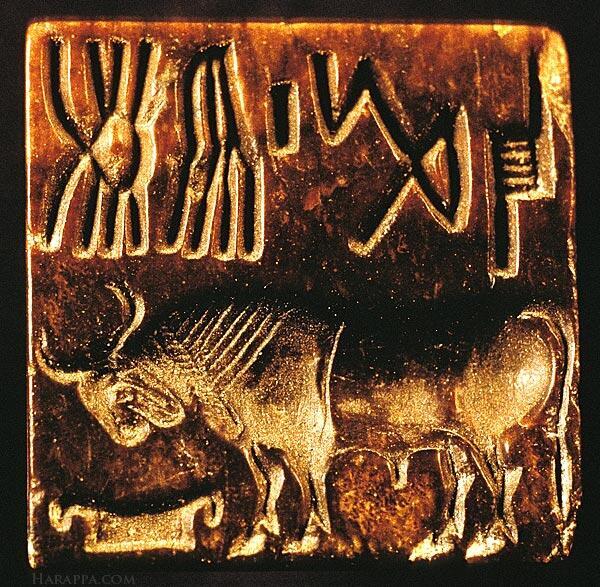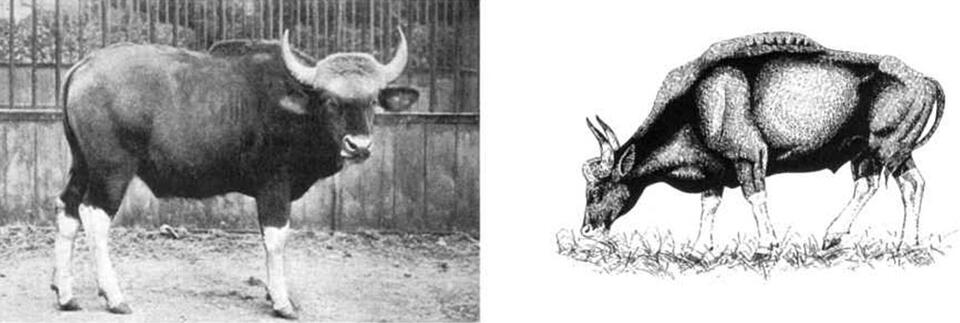A superb, thought-provoking paper by one of the most imaginative and interesting of ancient Indus archaeologists, able to reconcile the bigger picture with data and suppositions that often fit together very nicely. They certainly do in this paper.
Dr. Vidale begins by describing the creature at hand: "The South Asian gauris described as a powerful animal, sometimes attaining a height of over feet (187 cm) at the shoulder, and a length of almost 10 feet (312cm) from the nose to the tail. The colour of the adult animals is dark brown to shiny black; the sturdy legs from above the knees to the hoofs are whitish-buff, the hair short and fine. The upturned horns are tipped black, with cream hair covering the junction. The animal is distinguished by a powerful muscular mass on the upper back, resembling a massive hump; some pictures also show a row of deep skin wrinkles on the upper neck and a short dewlap, also marked by parallel folds that are perhaps represented by the lines deeply incised on the neck of the animal of the Indus seals. The gaur in the wild used to live in savannah woodlands, tropical monsoonic forests, dry forests and lowland tropical rainforests. It presently survives in large residual undisturbed forest tracts and in hilly regions below 1800-1500 m of altitude" (p. 148).
He then goes through a careful analysis of seals with the gaur, or short-horned bull found at Mohenjo-daro and elsewhere, "the second animal image, in absolute order of frequency, in the known standard seal repertory" (p. 149), even if at just below 5% it is far from the next highest in various counts, which is the unicorn at 58%. Shown with and sometimes without its manger, it turns up on the rare round seal found in Mohenjo-daro and Chanhu-daro, but in Mesopotamia, it is a different story. "The fact that in these round western seals the only animal icon is the short-horned bull cannot be considered a pure coincidence, given the fact that in the Indus Valley settlements the frequency of this same icon is much lower than that of the unicorn," (p. 150). Round seals are also associated with the Gulf region, where again the gaur is found on at least eight seals from Failaka and Bahrain. It also appears on cylinder seals from Susa on the Iranian plateau and in Bactria, many of these seals are today in the Louvre in Paris. While looking at the texts of these cuneiform seals is not definitive, it does open the possibilities of association with other features of trade with "Meluha," or the Indus region as it was probably called to the west, possibly even with the timber trade that is said to have flourished at different points between these civilizations.
From there the author expertly discusses what animal icons might have meant as social markers, what the symbol could have contained viz. aggressiveness or not, and then admittedly speculates on patronymic and other means of assessing the meaning of the connection between the short-horned bull and distant trading communities. He concludes: "These western gaur seals might show various transformations depending upon different forms of cultural interaction with the hosting cultures. Perhaps the earliest seals (let us say in pre- Akkadian times) used in the Mesopotamian market towns were quadrangular, as were the standard types used in the Indus region; they were direct translations of Indus seals, attempting to translate in different languages and with cuneiform inscriptions the messages usually conveyed by standard Indus seals. Later, Indian residents in the West (both in Mesopotamia and the Gulf) maintained the icon of the gaur, but adopted round steatite stamp seals instead of the normal quadrangular types, in which they probably used Indus characters or ideograms for rendering one or more foreign languages then currently spoken at the Meluhha villages. The few steatite cylinder seals with Indus icons and inscriptions found in Mesopotamia and Iran were probably direct efforts at adapting or “translating” the administrative standards and recording technologies of the Indus immigrants in the forms most familiar to the hosting communities. In Bactria, the two seals we discussed maintained the gaur symbol but not the Indus inscriptions, possibly reflecting the substantially non-literate culture of the local elites; the seal in chlorite and gold equates a Bactrian composite monster with the short-horned bull on a sledge, while the other possible seal might reproduce an Indus icon (the bull on a boat) by the means of a medium basically foreign to the Indus technologies of information processing, but deeply rooted in the Turanian world. I also wonder if the depiction of a bull on a boatin the heart of Bactria, instead of pointing to sea trade, might imply transportation by river boats. As precious beads were one of the most relevant trade items, both along the northern land tracks and the southern sea routes, it is quite likely that Indus bead traders, or naturalized families maintaining contacts with the Indus valley, identified themselves on the base of seals showing short-horned bulls, (p. 155).
Image: Fig. 1 A flat square double sided seal. On one side, four script symbols are inscribed in reverse, above a bison with head lowered to the feeding trough. A swastika motif turning counter clockwise is carved on the reverse. The seal is perforated from the side along the axis of the animal motif.
Fig 2. A young Indian gaur probably photographed in the 1920s (from Cornish s.d., 21.0).
Figure 3. A mithan (gayal) (from Simoons 1968).




